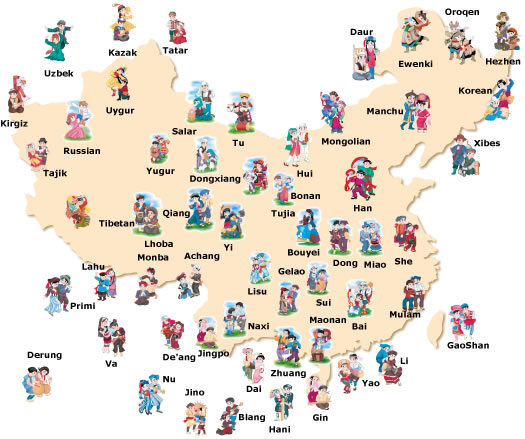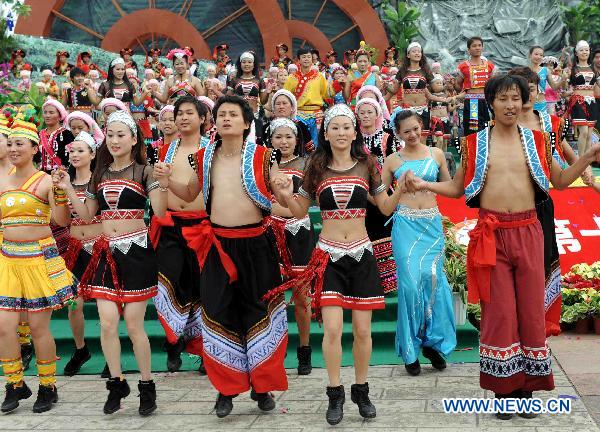


A map of China's 55 ethnic minority groups and their major locations. Photo from China cultural archives
China’s 2010 census put the population at 1.34 billion people, the highest in the world. With a land size of 9,572,900 square kilometres, China is the world’s third largest nation after Russia and Canada. The country has 56 different ethnic groups, with the majority Han people making up 91.6 per cent of the population. The 55 ethnic minority groups - mostly concentrated in western China – numbered 112 million in 2010, accounting for 8.4 per cent of the total population.
Averting acrimony, ensuring stability
Since the founding of the People’s Republic of China in 1949, the authorities have developed a number of policies aimed at ensuring harmony and balanced development amongst the country’s ethnic groups and areas. In order to give ethnic minorities a sense of belonging and say in the management of their affairs, autonomous administrative areas were created. Some 68 years on, it can safely be said that the policies have largely succeeded, given that the country has remained fairly stable and relations between various ethnic groups have been quite harmonious.

China's ethnic minorities are allowed to live their cultures freely. Photo by China News.cn
Ethnic equality
Regardless of population size, length of history and level of development, all Chinese ethnic groups are equal before the law. The State creates better opportunities and favorable conditions for ethnic minorities to develop and guarantees their legitimate rights and interests. Equality is a basic right conferred by the Constitution. For instance, all ethnic groups participate in the State Affairs Administration on equal footing and have the same rights to vote and stand for election.
In the National People’s Congress, NPC, every ethnic minority has appropriate numbers of deputies, and ethnic minorities with exceptionally small populations have at least a deputy each. The proportion of ethnic minority deputies to the total number is higher than their actual national population. Also, the Chinese People’s Political Consultative Conference, CPPCC, has members from all ethnic groups.
All ethnic groups enjoy equal rights to education, social life, politics, economy, culture, and spoken and written languages. Ethnic autonomous areas independently regulate their economy, are guaranteed economic development and receive State assistance. The law bestows on organs of self-government in ethnic autonomous areas the right to independently develop their own system of education based on their ethnic minority characteristics.
These organs of self-government also tackle illiteracy, ensure that nine-year compulsory education becomes universal, and develop different levels of education according to their peculiarities. The State offers preferential treatment to ethnic minorities in social and economic development and in admissions to institutions of higher learning.
Regional autonomy
Regional autonomy is practised in areas where people of ethnic minorities live in compact communities, and organs of self-government are established to serve them. The different levels of self-government are autonomous regions, prefectures and counties or banners; all equivalent to provinces, prefectural level cities and counties. The organs of self government are people’s congresses and people’s governments. Among the 155 ethnic autonomous areas for 45 ethnic minorities, some were established for one ethnic minority, while others are for several ethnic minorities. Over 1,000 ethnic minority townships have also been created.

Ethnic minority scripts like this Shui handbook are promoted by the Chinese government. Photo from Chinese cultural archives
Ethnic autonomous areas have the power to independently manage their internal affairs, decide their development agenda and engage in foreign trade. Ethnic autonomy has been practised in China for over 60 years, though the country has been a united, multi-ethnic State for over 2,000 years. All ethnic groups, State organs and social organizations must abide by and implement the Law on Regional Ethnic Autonomy.
Unity, harmony
Conflicts between different ethnic groups are promptly addressed through consultations and in respect of the law. By safeguarding the interests of the people and country, cordial long-term ethnic relations and harmony have been ensured.
The aim is to narrow the gap between ethnic minority people and their areas and the more developed areas of China like the south and east. Minority areas make use of their vast expanses of land and rich natural resources to ensure development, in addition to receiving support from the central government. There is also mutual complementation between different areas so that all become affluent. The State ensures the construction of infrastructure and key projects, and the efficient exploitation of local natural resources to foster development.
The beauty and mix of China's ethnic minority cultures explain the country's harmonious co-existence and stability. Photo from China cultural archives
Preference is also given to the development of border zones and areas where ethnic minorities with small populations live in compact communities. Meanwhile, China in 2000 launched the "Develop the West" campaign to accelerate the development of ethnic minority areas where 11 provinces and autonomous regions are found. Moreover, the more developed parts of the country are paired up with ethnic minority areas to prop up their development.
Culture, education
This has been achieved by respecting cultural diversity, innovating while protecting cultures, and strengthening the construction of cultural facilities. Ethnic minority artistic organizations and educational systems have been established and special funds released for their functioning.
Languages, scripts
The equality of spoken and written languages reflects the level of China’s implementation of ethnic equality policies. All ethnic groups have the right to use and develop their spoken and written languages. Important national meetings like the annual sessions of the National People’s Congress and the Chinese People’s Political Consultative Conference use the spoken and written languages of ethnic minorities for official communication. Documents are also provided in ethnic minority languages, with translation services offered.

Freedom of religious belief is guaranteed to all Chinese. Photo from China cultural archives
All ethnic groups have the right to use their spoken and written languages in legal proceedings and for teaching. Ethnic minority areas also carry out bilingual education in their local languages and in Chinese. More so, ethnic groups are encouraged to learn each other’s spoken and written languages. On the other hand, the State promotes the use of spoken and written ethnic minority languages in publishing, cinema, and radio and television broadcasts.
Cadres, customs, religious beliefs
Ethnic minority cadres are trained and deployed to assist with local development and conflict resolution. It is mandatory for government organs, schools, enterprises and public institutions with relatively large Muslim workers to provide them special dining halls for serving food according to Islamic tradition. Where this is not possible, Muslims are offered special food allowances, including convicted prisoners. Festival, marriage and burial customs of minorities are respected as well as the freedom of religious belief.
*Kimeng Hilton Ndukong, a contributor to People’s Daily Online, is Sub-Editor for World News with Cameroon Tribune bilingual daily newspaper in Cameroon. He is currently a 2017 China-Africa Press Centre, CAPC fellow.
 Fire brigade in Shanghai holds group wedding
Fire brigade in Shanghai holds group wedding Tourists enjoy ice sculptures in Datan Town, north China
Tourists enjoy ice sculptures in Datan Town, north China Sunset scenery of Dayan Pagoda in Xi'an
Sunset scenery of Dayan Pagoda in Xi'an Tourists have fun at scenic spot in Nanlong Town, NW China
Tourists have fun at scenic spot in Nanlong Town, NW China Harbin attracts tourists by making best use of ice in winter
Harbin attracts tourists by making best use of ice in winter In pics: FIS Alpine Ski Women's World Cup Slalom
In pics: FIS Alpine Ski Women's World Cup Slalom Black-necked cranes rest at reservoir in Lhunzhub County, Lhasa
Black-necked cranes rest at reservoir in Lhunzhub County, Lhasa China's FAST telescope will be available to foreign scientists in April
China's FAST telescope will be available to foreign scientists in April "She power" plays indispensable role in poverty alleviation
"She power" plays indispensable role in poverty alleviation Top 10 world news events of People's Daily in 2020
Top 10 world news events of People's Daily in 2020 Top 10 China news events of People's Daily in 2020
Top 10 China news events of People's Daily in 2020 Top 10 media buzzwords of 2020
Top 10 media buzzwords of 2020 Year-ender:10 major tourism stories of 2020
Year-ender:10 major tourism stories of 2020 No interference in Venezuelan issues
No interference in Venezuelan issues
 Biz prepares for trade spat
Biz prepares for trade spat
 Broadcasting Continent
Broadcasting Continent Australia wins Chinese CEOs as US loses
Australia wins Chinese CEOs as US loses